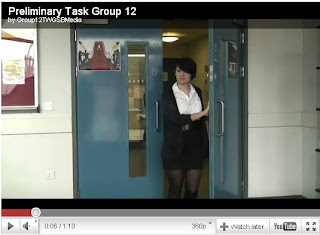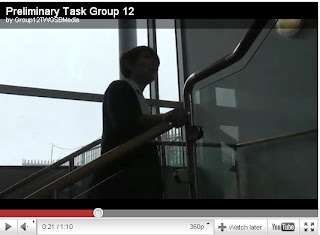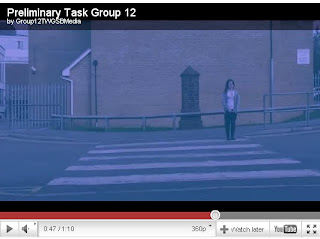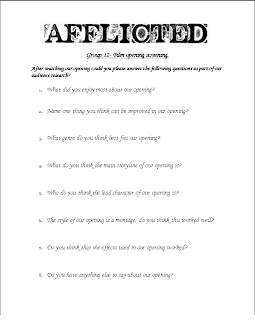Tuesday, 10 May 2011
Group Navigation of Evaluation, Final opening and Preliminary task.
Becki Ashby
-Evaluation 1
-Evaluation 2
-Evaluation 3
-Evaluation 6
Abbi Potter
-Evaluation 1
-Evaluation 2
-Evaluation 3
-Evaluation 6
Group
-Initial Audience research
-Target Audience
-Audience research
-Evaluation 7
-Overall evaluation, other half of Evaluation 7
Final Opening
-Our final opening and evaluation.
Preliminary task
-Our preliminary task and evaluation
Storyboard
-Our storyboard
Monday, 9 May 2011
Group - Final Piece + Overall Evaluation
Our brief for the final task was to create a 2 minute film opening that was typical to that of a genre that we could choose between a choice of thriller, horror and teen drama. Our chosen genre was a psychological thriller.
- When in the beginning stages of this project we had to firstly research ALL of the genres that we had an option in using to get an idea of the typical conventions for those genres and how a film opening might look.
- After having completed this thorough background research we decided to choose our main genre as a thriller.
- At this point we already had a few ideas of what our plot might be and what kind of shots and compositions we might wish to use. Watching The Bourne Supremacy opening and the Seven opening we gained inspiration for doing a postmodern and almost a hallucinogenic style of opening.
- Once having decided on our storyline we then had to consider what locations we would want to use for our opening to fully communicate our genre. Therefore, we had to go on location recces to places such as High Brooms station (where our murder scene is shot).
- Interesting shot sizes and the framing of those shots e.g.
- The use of blank black shots to help create tension.
- The layering of different tracks of music
- The effects that we used e.g.
- The titles e.g.

- Some of the sound doesn't anchor the narrative as well as it could
- The cutting rate could also do with improvement to help to create a bigger build up of tension
Group - Evaluation 7 - Preliminary Task: What We've Learnt.
The brief for our preliminary task was...
-The use of continuity editing needed to be incorporated into out footage, this means the illusion of a continuous line of action.
-The use of a short conversation was part of the brief, for this we chose to have two separate sets of dialogue as a conversation did not fit the conventions of our style of opening.
-Opening a door was another part of our brief, this was an example of continuity editing used in our task. Here is an example of this from our task...

-Experimenting with different camera angles and techniques was also part of our brief, this includes shots such as CU, LS, MS, Canted angles, Tracking shots and effects used within editing. Here is an example of this...

Choosing the genre, costume and props were key parts in producing a creative response to the brief. The genre we chose was psychological thriller which matched the genre we were planning to do for our opening. There were some limitations of this...
-As we were in school we did not have the access to any other locations other than on the school grounds, we tried to overcome this by using places which look as if they are not in a school such as the road and zebra crossing outside the school.
-The costume was also restricted by the fact we were in school as we were in our school uniform thus could not show character exposition through costume.
-We faced the same problems with props which is why we decided to use effect's when editing our task in order to make a creative response. Here is an example of this...
 The planning we used for our preliminary task was...
The planning we used for our preliminary task was...-Looking over previous filming experiences such as the Wilderness wood reccie and identifying shots and specific features which we thought worked well and planned to use in our preliminary task.
-Thinking about the narrative of our preliminary task, for example writing a script, although there is not a lot of dialogue in ours.
-Finding a location to film our task, we chose to use the road outside the school as well as the stairs and corridor. Here is an example of this

-We then done some practice shots around the school so that we were fully prepared for when we actually filmed our task, from this we could identify what worked well and what we were going to re create in our real thing.
-Another problem was the costume, again as we were in a school environment we were restricted as to what we could use, in order to overcome this we ensured that costume would not be a big part of our narrative therefore making it irrelevant.
-Another problem we faced was the continuity editing of our piece, neither of us had previous experience in editing therefore found this hard, in order to overcome this we ensured that we left our selves enough time to edit ensuring that we could overcome any problems we faced.
-Strengths: I think that the effects used in our preliminary task such as the colours flashing worked really well and gave us inspiration for our final piece. This helped to create the sense of confusion that we were aiming for. The music also worked well in order to create this effect.
-Weaknesses: I think that the main weakness of our piece is the continuity editing although this could be easily worked on it does let the task down as a whole.
Our preliminary task...
Tuesday, 3 May 2011
Group- Results from audience research- screening.

Results from questionnaire
AP Evaluation 6 - Media Technologies
- Because this task was a group task we needed to work somewhere where it was easy for us to work collaboratively and to have all our research and ideas in one place. By using http://www.blogger.com/ and 'blogging' we successfully managed to do so. Moreover by having a definitive place to record our progress etc we were able to focus on individual points and be more selective with our research because we could assign each other particular tasks.
 To actually film our opening sequence we used a 1080p High Definition Camcorder and a tripod. The high definition gives a clearer and more crisp picture and the tripod helps to keep the camera still in order to avoid shaky camera movement that spoils the atmosphere or tension that you try to create with smooth filming. However, shaky camera movement is necessary at times when trying to make the audience feel involved.
To actually film our opening sequence we used a 1080p High Definition Camcorder and a tripod. The high definition gives a clearer and more crisp picture and the tripod helps to keep the camera still in order to avoid shaky camera movement that spoils the atmosphere or tension that you try to create with smooth filming. However, shaky camera movement is necessary at times when trying to make the audience feel involved.
- Where lighting is concerned, we were very fortunate in that when we did the bulk of our filming the weather was exactly how we wanted it and therefore helped with the composition of our shots. For example, when we were out shooting in the park the sun was shining and so we placed the camera in different angles so that we could achieve different effects and see different shadows.
- We faced very little problems on our actual shoots, the weather was always how we needed it to be. However, some of our CUs of natural objects were unsteady and shaky because a tripod was not used. To creatively overcome this, we used our technique of montage editing so we incorporated our shaky shots to create disorientation.
- At first we spent a lot of time experimenting with different effects and colours to fully emphasise the fact that our montage was a dream, for example, using these effects for surrealism. When we had finished our 'experimenting' we ended up with a sequence that was more ambiguous than we wanted and too much was happening that you couldn't understand the plot of the opening.
- Furthermore, we decided to use a smaller range of effects to give a sense of continuity and flow to a piece that was not supposed to be continuous. This eventually worked really well and was easier to understand but at the same time also kept you active and open to different possibilities.
- To edit all of our footage and to finally create our opening sequence we had to use an editing software called Adobe Premiere Elements, upload our footage to the software and on to a timeline.
- Once we had all our footage uploaded and placed onto the timeline in a rough idea of where we wanted it we started to cut the footage down to our requirements. This proved to be a challenge. After having an overall 30minutes of footage we managed to cut it all down to 50 seconds. This was obviously not a great start.
- However, we managed to prioritise different shots and slightly change our timeline so that we met the required 2 minutes of film. From this we have now learnt to do as much filming as you can even if you don't think you need to, we also learnt that planning and storyboarding is extremely important.
- Compared to real film production, our opening is different because we didn't actually need to make a whole film and so we didn't need to get bankable stars and think too seriously about finance and the final quality of our piece. We also didn't have the advanced equipment that professional filmmakers would have or the expert skills in editing. However, overall I am very pleased with our outcome and with our editing.
- In addition to this there was also the issue of the timescale we were given, which would be quite difficult to compare to a real film production.
AP Evaluation 3 - Media Institutions
 Distribution companies that I have researched include Fox Searchlight Pictures, Paramount Classics, Miramax and Optimum Releasing. For our particular film i would hope to use Optimum Releasing as it is a British based distribution company that focuses on independent films. They are one of the most prominent distributors in the UK concerning independent cinema.
Distribution companies that I have researched include Fox Searchlight Pictures, Paramount Classics, Miramax and Optimum Releasing. For our particular film i would hope to use Optimum Releasing as it is a British based distribution company that focuses on independent films. They are one of the most prominent distributors in the UK concerning independent cinema.










